Mad Hedge Biotech & Healthcare Letter
April 9, 2020
Fiat Lux
Featured Trade:
(A SLIVER OF HOPE FOR CORONAVIRUS)
(MYL), (NVS), (BAYRY), (PFE)
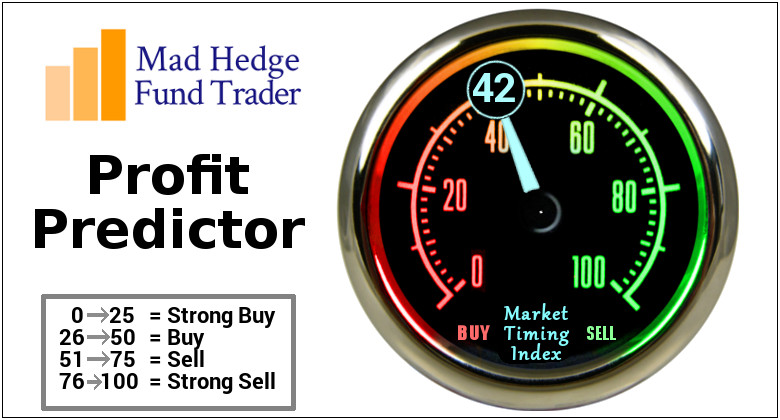
Mad Hedge Biotech & Healthcare Letter
April 9, 2020
Fiat Lux
Featured Trade:
(A SLIVER OF HOPE FOR CORONAVIRUS)
(MYL), (NVS), (BAYRY), (PFE)

To this day, there’s still no solid proof that any drug can treat or prevent infection with the deadly coronavirus. Faced with an exploding pandemic that brings an alarming death toll, the public is eager -- desperate -- for a sliver of hope and some news regarding discoveries of COVID-19 treatment.
Lately, the drug that has been gaining so much attention is hydroxychloroquine. This is primarily thanks to Trump’s endorsement, with the president going as far as labeling it a “miracle” drug.
By now, we’ve become all too familiar with the story behind this “miracle” drug.
Trump was watching TV the night before and saw a feature about a Michigan woman who was suffering from COVID-19 for 12 to 14 days. Her suffering was so intense that she felt she would die anytime soon. One night, she asked her husband to find hydroxychloroquine.
Four hours after taking it, she felt better and eventually recovered.
While health experts are still waiting for conclusive evidence on the drug’s efficacy, this story inspired Trump to urge the public to try it as well.
Aside from describing it as a potential cure, Trump is also recommending hydroxychloroquine as a preventive measure for health workers. His point is that there’s really nothing to lose here. After all, the drug has been used for decades so “it’s not going to kill anybody” compared to completely novel treatments.
In fact, he has been so intent in using hydroxychloroquine to cure COVID-19 patients that he ordered 29 million doses added to the government’s cache of medical supplies.
Just what is hydroxychloroquine?
This is a prescription drug approved to treat malaria decades ago. It can also be prescribed to treat autoimmune diseases such as lupus and rheumatoid arthritis. It’s called by its brand name Plaquenil as well.
Is it really effective to treat COVID-19?
The answer remains unclear. However, there are a couple of studies that point to promising results.
One is a laboratory study using cultured cells. In this research, it was found that chloroquine has the ability to prevent the coronavirus from invading the cells. Obviously, blocking the virus means protecting the body from the illness.
However, scientists issued a word of caution about this.
They reminded us that the drugs that work well in killing off viruses in petri dishes or test tubes do not necessarily translate to the same results in the human body.
As for hydroxychloroquine, studies showed that it can’t prevent or cure influenza and other viral diseases.
This doesn’t mean that hydroxychloroquine is useless as a COVID-19 treatment.
It just shows that more trials are needed to determine its actual effect. Several studies have been launched to figure out the answer to this.
In Detroit alone, there will be 3,000 patients set to participate in the trial to come up with a formal and conclusive study on hydroxychloroquine.
In a nutshell, what the health experts are saying is that the celebration might be a tad premature.
So this leads to a lot of investors to wonder which companies stand to benefit if hydroxychloroquine gets approved as a COVID-19 treatment.
Probably no one.
Keep in mind that this is an old drug, which came to the market sometime in the 1940s. Hence, it’s highly unlikely for it to become a blockbuster drug for any company.
Right now, several companies are already making it, including Novartis (NVS) and Bayer (BAYRY).
However, investors interested in buying cheap biotech stocks might be interested in generic drug maker and Mylan (MYL) are also in the running.
When Trump started touting the effects of hydroxychloroquine on COVID-19 patients, Mylan immediately restarted its production of the tablets.
The company aims to have the drug available in the market by mid-April, targeting up to 50 million tablets for over 1.5 million people.
Like I said, hydroxychloroquine isn’t going to be a high-selling drug for any company.
Nonetheless, this could provide the much-needed momentum for Mylan as its investors start to lose confidence in the company.
With the company back in the spotlight, it can easily redirect everyone’s attention to its upcoming merger with Pfizer’s (PFE) Upjohn unit to form a new company called Viatris.
This combined company will hit the ground running as it buys two assets from Pfizer.
One will be Meridian, which is the maker of EpiPen along with other auto-injectible treatments. The second is Mylan-Japan, which has been the generics collaboration unit of Pfizer and Mylan since 2012.
Both units recorded $598 million in annual revenue in 2019.
Viatris’ portfolio will also include a number of top-selling products like erectile dysfunction and pulmonary arterial hypertension Viagra and arthritis Celebrex.
The lineup will even feature the blockbuster cholesterol drug Lipitor, which generated more than 2 billion in sales last year alone.
According to the terms of the deal, Pfizer shareholders will own 57% of Viatris while Mylan shareholders get 43%.
Due to the upcoming merger, Pfizer went ahead and upped the 2020 guidance for Upjohn’s revenue from the $7.5 billion and $8 billion range to $8 billion and $8.5 billion.
The Viatris spin-off is expected to be completed by mid-2020.
For years, Mylan has been plagued with numerous issues like pricing concerns and even lawsuits.
Hence, this merger with Upjohn is considered a crucial turning point for Mylan. It represents a fresh beginning from this previously embattled stock.
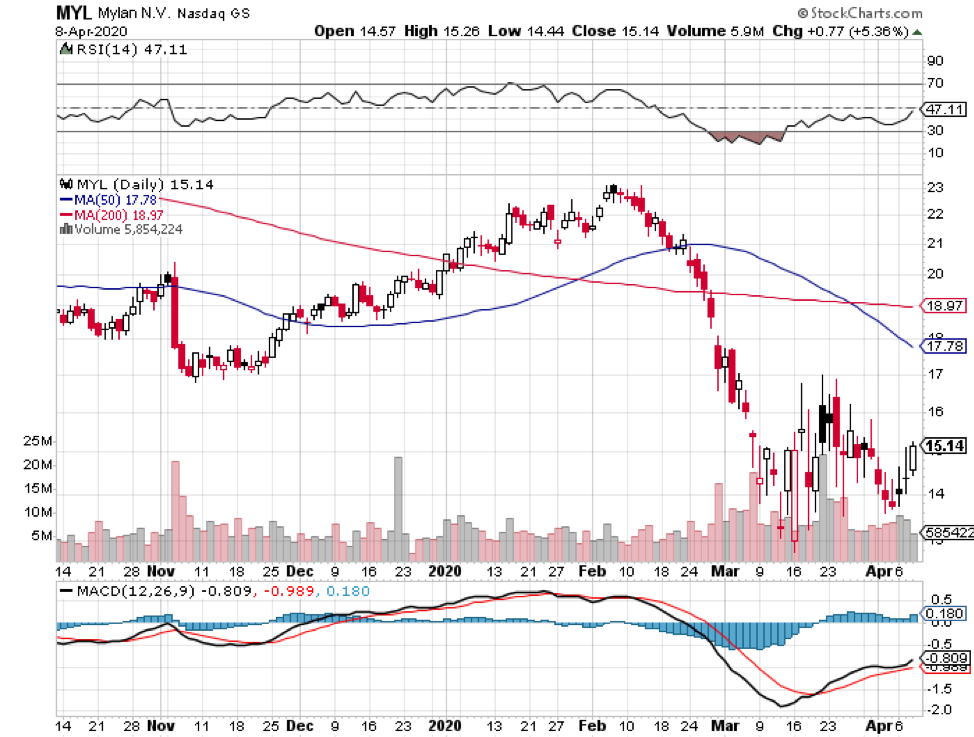
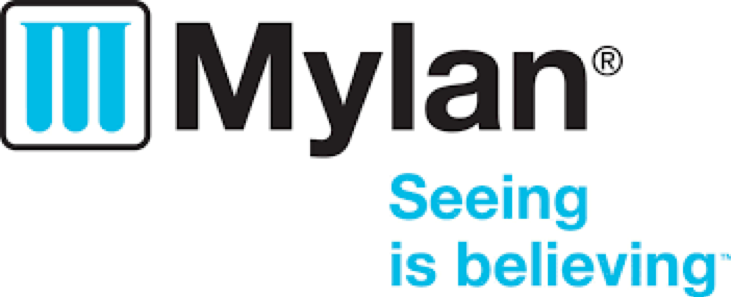
Mad Hedge Biotech & Healthcare Letter
March 26, 2020
Fiat Lux
Featured Trade:
(PFIZER PUSHES AHEAD WITH A CORONA CURE),
(PFE), (BNTX), (MYL)
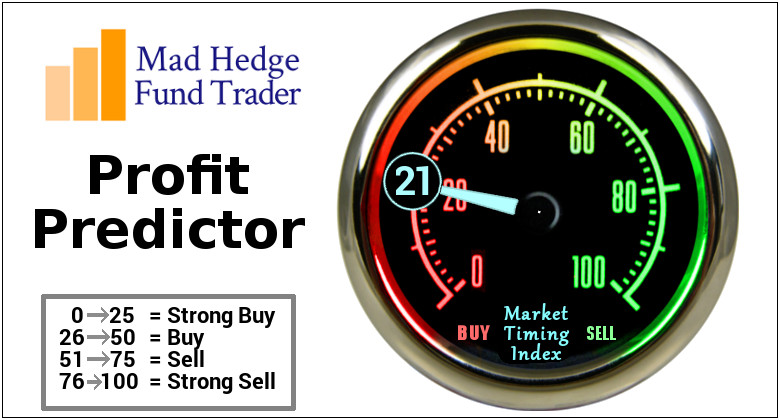
Pfizer (PFE) has been widely recognized as one of the leading and largest vaccine makers in the industry.
Now, one of America’s biggest biotechnology companies will throw its weight behind German firm BioNTech (BNTX) in its quest to develop a COVID-19 vaccine.
Prior to this announcement, BioNTech has already been working inside China in collaboration with Chinese biopharmaceutical company Fosun Pharma (SHA: 600196).
Its partnership with Pfizer will entail efforts outside China and will be in collaboration with the University of Pennsylvania and the Bill and Melinda Gates Foundation. Specifically, the work will be done at sites in the US and Germany.
What we know so far about this experimental COVID vaccine is that it’s called BNT162.
Like the experimental vaccine from Moderna (MRNA), BioNTech’s version is also based on messenger RNA. Clinical trials will start by April.
BioNTech shares were up 55% following the announcement of this collaboration with Pfizer. Meanwhile, the giant biotechnology company’s shares jumped by 3.8%.
Before this coronavirus vaccine collaboration, BioNTech and Pfizer were already partners.
In 2018, the two companies agreed to work together in developing flu vaccines based on mRNA.
However, this recent expansion of their partnership gained more attention because of the intense focus on the efforts to combat the novel coronavirus.
The output of this partnership won’t be kept within the confines of the companies though.
According to Pfizer, any information or tool it comes up with will be shared with the entire scientific community.
The company also pledged its assistance to small biotechnology companies working on COVID-19 treatments and vaccines, going as far as offering its manufacturing power to help speed up the process.
Aside from its coronavirus efforts, the giant biotech has been working on plans to bolster its revenue streams.
Addressing the loss of exclusivity for seizure disorder drug Lyrica, an issue that weighed on the company’s top and bottom lines last year, Pfizer has been gearing up to merge the Upjohn unit with Mylan (MYL).
The merged companies will be called Viatris.
This is a good strategy. Since Upjohn is home to Lyrica and several older drugs nearing the end of their patent exclusivity, separating this unit will allow Pfizer to streamline its portfolio.
Instead of holding on to Lyrica as an anchor, the “new” Pfizer will focus on its new line of blockbuster drugs like breast cancer medication Ibrance and blood clot treatment Eliquis.
Apart from these, Pfizer is investing more on marketing its rising stars like Vyndaquel. The company’s pipeline is also filled with potential blockbusters particularly its 20-valent pneumococcal vaccine.
Although the Upjohn-Mylan merger will inevitably lower Pfizer’s dividend, shareholders of the giant biotech will still own part of Viatris. That means they would have a share in the dividend of the merged companies as well.
The combination of the dividends from both Pfizer and Viatris would total to roughly the same amount as the “old” Pfizer, which currently yields 5%.
What we’re experiencing right now is definitely unprecedented. COVID-19 has mutated from a respiratory disease affecting a single province in China into a global threat endangering everyone’s physical and financial well-being.
However, there’s always good news.
From an objective perspective, this coronavirus crisis has provided a rare opportunity for investors. After all, stock market corrections are actually quite common occurrences.
Looking at each correction in equities in the past, you can see that these were eventually triggered by a bull-market rally.
Remember, the ongoing vaccine research conducted by companies worldwide will yield results sooner or later. So even if COVID-19 is here to stay, it will no longer be a deadly threat in the long run.
In times like these, I think it’s more prudent to consider major biotechnology stocks when looking to invest.
This is because they have a higher capacity to keep trucking through this health crisis and to deal with its aftermath.
Despite the growing fear that this pandemic will lead us to a recession, Pfizer can still be easily categorized as a profitable company.
Considering that it’s trading at merely 13 times its expected earnings, this stock is quite a bargain.
Pfizer has a strong cash flow. Its long history shows that it has also weathered economic storms.
More importantly, it has a product pipeline that we find essential regardless of pandemics and strict quarantines. It doesn’t hurt that they’re priced attractively as well.
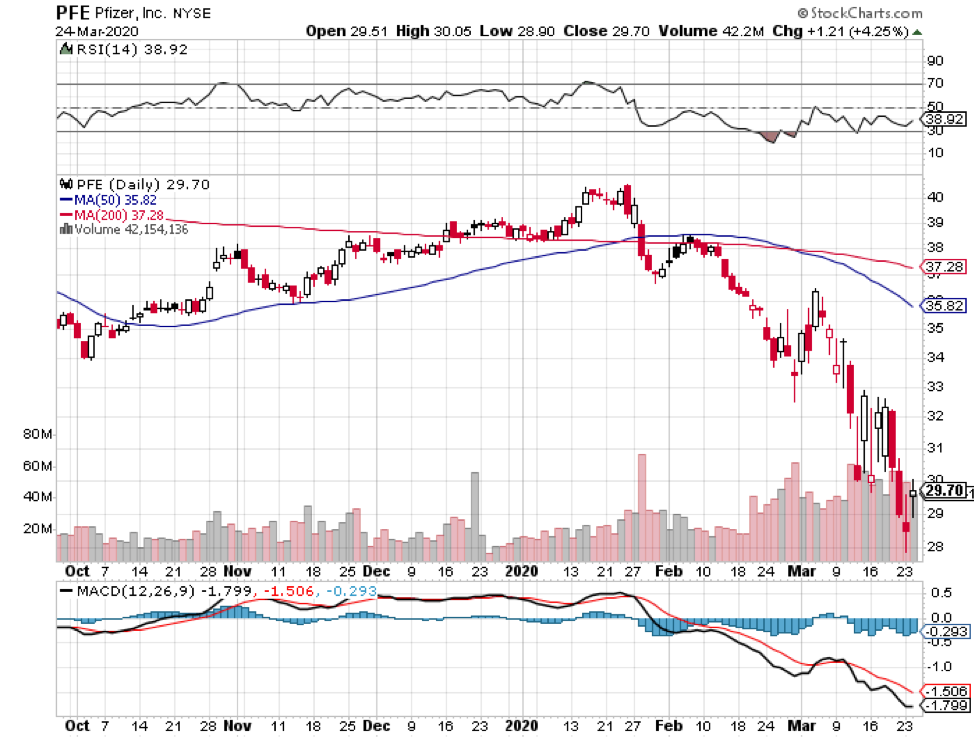
Mad Hedge Biotech & Healthcare Letter
January 23, 2020
Fiat Lux
Featured Trade:
(BIOGEN’S BIG ALZHEIMER’S BET),
(BIIB), (BMY), (PFE), (IONS), (MYL)
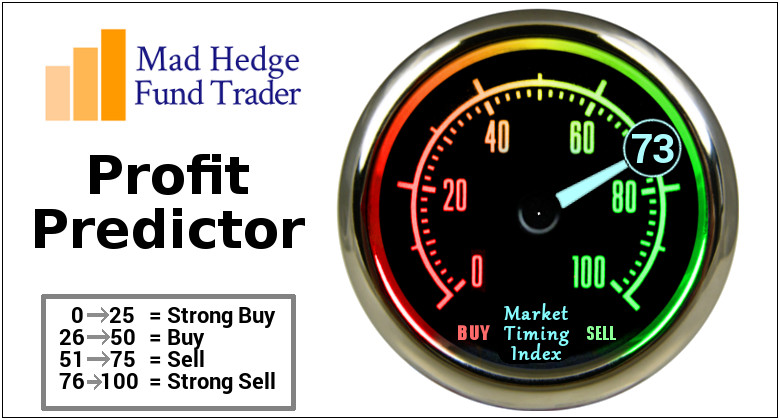
Biotech giant Biogen (BIIB) failed to impress in 2019. Surprisingly, the company is sticking to its strategy this 2020.
Despite the majority of biotech companies posting market-beating gains last year, Biogen’s shares suffered a 1.4% loss to their value. Taking a look at its performance, there are three obvious reasons why Biogen stock lost ground in 2019.
For one, its revenue generation, particularly for the multiple sclerosis portfolio, flatlined last year. Another reason is the company’s move not to acquire another company the way Bristol-Myers Squibb (BMY) took over Celgene.
Biogen’s decision to not make any major acquisition in 2019 was deemed as an inability to achieve significant business development milestones, thereby failing to positively influence the company’s near-term outlook.
The third reason is Biogen’s decision to halt trials for its widely anticipated Alzheimer’s drug candidate, Aducanumab, in March 2019.
With so much invested in the development of this product, the investing community expected Biogen to completely drop the project altogether.
However, it seems that Biogen has found a way to resolve the issues it initially encountered in the Aducanumab study.
In October 2019, the company announced its plan to resurrect all its Aducanumab-related efforts. To show its commitment to the plan, Biogen kicked off 2020 with a massive purchase from Pfizer (PFE).
Since Biogen aims to apply for regulatory approval by early 2020, the company has been aggressively pursuing avenues to ensure that its Alzheimer’s drug candidate will get the green light as soon as possible.
One of its efforts is its $700 million deal to buy Pfizer’s castoff drug, PF-05251749.
The Pfizer drug was created to treat Irregular Sleep-Wake Rhythm Disorder suffered by Alzheimer’s and Parkinson’s disease patients. This condition, also known as Sundowning, affects 20% of those afflicted by these neurological diseases.
According to the terms of the deal, Biogen will shell out $75 million upfront to gain the rights to the Pfizer drug.
The company will also pay an additional $635 million in the form of milestone payments. Pfizer will receive tiered royalties as well.
On top of this $700 million deal with Pfizer, Biogen also added another $45 million to fund its Alzheimer’s research with Ionis Pharmaceuticals (IONS). Apart from these, the two companies have been working on ION859, which is a possible treatment for Parkinson’s disease.
As if all of these are not enough to show Biogen’s dedication to finding the cure for Alzheimer’s disease, the company has a similar drug in its pipeline: BAN2401. This new drug, which uses a similar approach to Aducanumab, is actually already in its late-stage testing phase.
However, Biogen’s deal with Pfizer is not the first of its kind.
Prior to this, the company paid a whopping $300 million upfront to Bristol-Myers Squibb to own the rights to neurological drug Gosuranemab. Unfortunately, that study failed to deliver the desired results.
Even though Biogen has yet to actually file for regulatory approval for Aducanumab, the company is already preparing for the treatment’s launch this year. This is a rather confident move especially in light of the niggling doubts on the drug’s approval.
Apart from working on Aducanumab, Biogen has been testing for a higher dosage for spinal muscular atrophy medication Spinranza. This is done as a precautionary measure against Novartis’ (NVS) blockbuster gene therapy Zolgensma.
Its exclusive rights on Tecfidera, which has been challenged by Mylan (MYL), is also anticipated to hold until 2028. This means Biogen can still expect to reign supreme in this niche, hanging on to its blockbuster drug that raked in $4.3 billion in 2018 alone and $2.15 billion in the first half of 2019.
In addition to Alzheimer’s and Parkinson’s disease, Biogen is active in searching for treatments for Lou Gehrig’s disease along with stroke and choroideremia as well.
Biogen has also set in motion its plan to venture into rare eye diseases via its $800 million acquisition of Nighstar Therapeutics back in June 2019.
Notably, though, Biogen has been steering away from any major acquisition in 2020.
This strategy could be a stroke of genius if the company’s bet on Aducanumab pays off.
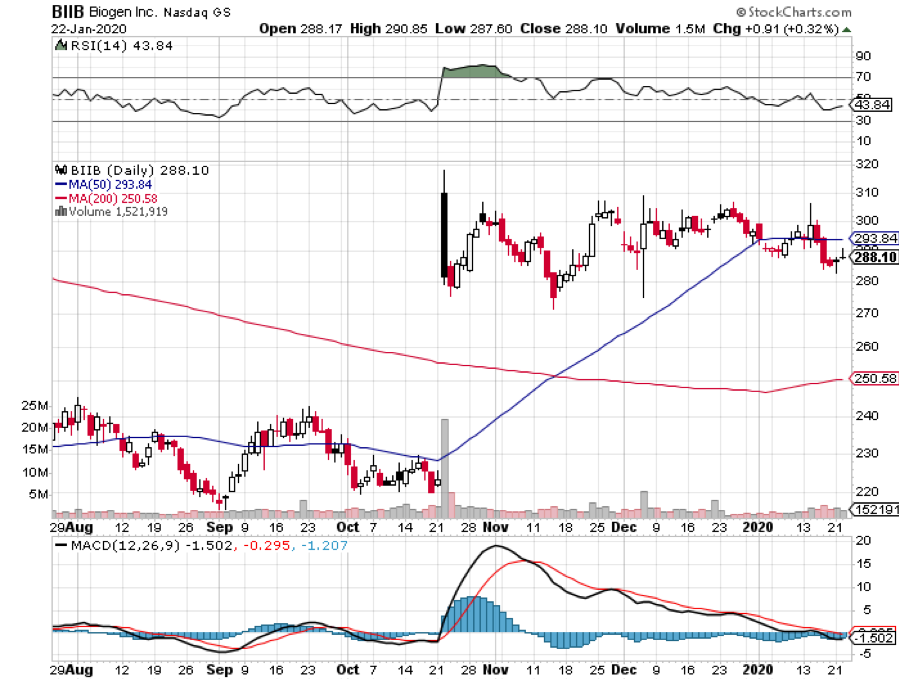

Mad Hedge Biotech & Healthcare Letter
January 14, 2020
Fiat Lux
Featured Trade:
(CALIFORNIA JUMPS INTO THE DRUG BUSINESS)
(MYL), (TEVA), (RHHBY)
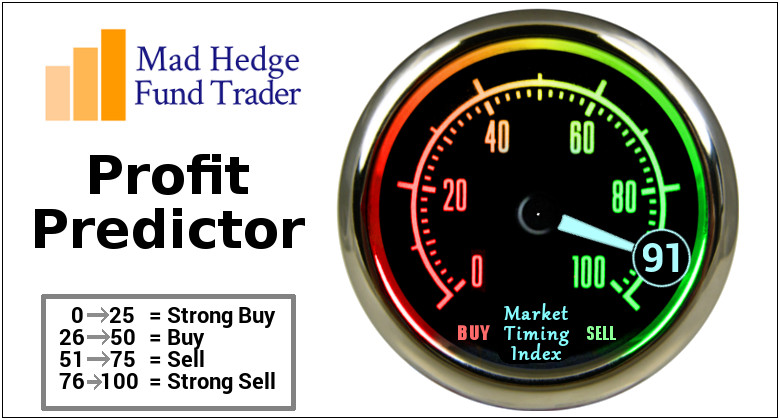
The bio-pharmaceutical industry, including the biotechnology sector, is in for another shock.
Taking a page off Elizabeth Warren’s book, California Governor Gavin Newson announced his plan to create the first-ever state-run prescription drug label in the country.
This move would be an ideal way to leverage the size and power of the California population in terms of negotiating advantageous pricing with generic drug manufacturers.
Wielding California’s massive purchasing power courtesy of the 40 million residents, almost 33% of which are enrolled in Medicaid or Medicare, Newsom believes that the government can get generic drugs for substantially lower prices from the manufacturers. This idea is part of Newsom’s broader vision to lower the healthcare costs in California.
In effect, the Golden State is stepping in where the federal government has failed to act. Washington should have used their massive purchasing power as a cudgel to lower prices decades ago. We’ve seen a half-century of talk, but no action.
Research from the Kaiser Family Foundation shows that 6 out of 10 Americans take a prescription, with 79% of them complaining about the unreasonable costs of these drugs.
As a result of these prohibitive prices, 3 in 10 Americans no longer take their prescribed medications adding hugely to the nation’s health care bill.
Even governments find it challenging to keep up with the costs of healthcare, with California’s Medicaid program for the less fortunate, otherwise known as Medi-Cal, reached over $100 billion annually in state and federal spending alone.
Inevitably, the skyrocketing prices pushed people to look at generic medications as more reasonable alternatives to brand name medications.
However, Newsom’s announcement wasn’t met with an overwhelmingly positive response from the generics sector either.
In fact, the Association for Accessible Medicines, the advocacy organization for generic drug manufacturers, only sent out a polite message regarding Newson’s announcement.
The group said that they "look forward to working with California to help expand access to safe, affordable and effective generic and biosimilar medicines, but let's make our decisions and policies based on the best data and science available." You couldn’t get any more anodyne.
Despite their lukewarm response to this plan, two major players in the generic pharmaceutical industry have already been identified as the front runners for this shift to generics movement: Mylan (MYL) and Teva Pharmaceutical Industries (TEVA).
To say that 2019 was an awful one for Mylan is an understatement. The generic drugmaker faced a slew of issues including declining sales in their North American market, endless legal battles, and even exclusivity loss for its top-selling impotence treatment Tadalafil (Cialis).
However, Mylan moved to turn things around in July 2019 when it entered a merger agreement with Pfizer’s (PFE) generic unit Upjohn. The two companies will turn into one entity, called Viatris, and will be launched by mid-2020.
According to the terms of this deal, Viatris will be handling the off-patent but lucrative branded drugs of Pfizer such as cholesterol treatment Lipitor, pain medication Celebrex, and erectile dysfunction and the blue erectile dysfunction drug Viagra.
This agreement aims to inject more money into Mylan’s research and development team for them to create more complex generics and biosimilars.
At the same time, the new company will already have a “ready-made” tried and tested drug portfolio courtesy of Pfizer’s off-patent previous blockbusters.
Apart from the Pfizer’s lineup, Mylan also has a number of key products to contribute to Viatris.
One is a biosimilar of Roche’s (RHHBY) blockbuster breast cancer drug Herceptin (it added four years to the life of my first wife). The launches of promising products, like biosimilar versions of Teva’s multiple sclerosis injection Copaxone and GlaxoSmithKline’s (GSK) asthma medication Advair, are also positive indicators of growth.
With these decisions, Mylan is expected to have a brighter 2020.
Another generic drug maker that’s expected to make a comeback in 2020 is Teva.
In 2019, everything that could possibly go wrong went wrong for this company. As a refresher, here’s what it had to endure: executive leadership turnover, bribery allegations, generic competition for its top-selling drug Copaxone, and of course, the opioid lawsuits from 44 states.
Needless to say, Teva’s profit estimates tumbled and its dividend was shelved. Worst, its debt load has been a huge warning sign that repelled investors left and right.
However, Teva has managed to turn things around.
The opioid lawsuits are reaching a reasonable settlement and the company now has a stronger leadership team. More importantly, it has been successful in cutting down its expenditures. If things go smoothly, Teva is expected to save $3 billion in yearly expenses to improve its profit margins in 2020.
On top of these, Teva has regained its footing in the generic drug market via the steady climb in terms of sales of its newer branded treatments, Ajovy and Austedo.
All in all, the stage is set for Teva to make its comeback and patient investors should expect to be richer in 2020.
Since both generic drug makers churned out less than stellar numbers in 2019, the stocks are likely undervalued at the moment. Hence, it’s important to take advantage of this and buy before these regain momentum and the prices skyrocket once again.
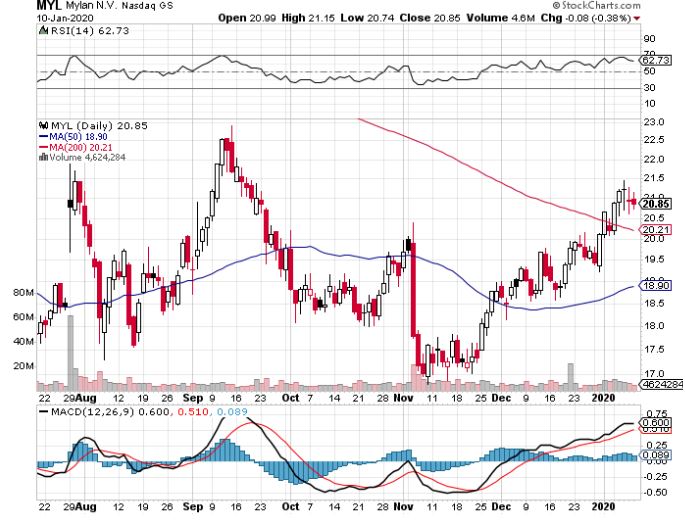

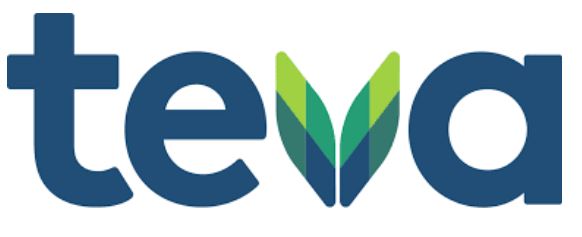
Mad Hedge Biotech & Healthcare Letter
October 31, 2019
Fiat Lux
Featured Trade:
(ONE PLUS ONE EQUALS THREE WITH THE PFIZER-MYLAN DEAL),
(PFE), (MYL)
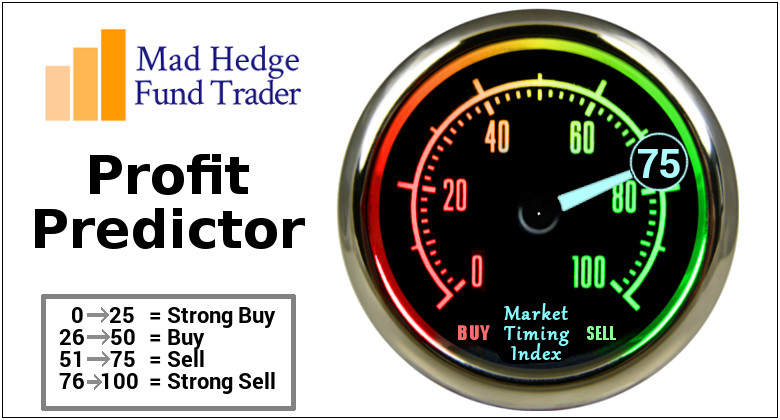
"Greater than the sum of its parts." This is how the executives of Pfizer (PFE) described its merger with generic drug company Mylan NV (MYL) in the third quarter of 2019.
The deal, which is specifically between Mylan and Pfizer's off-patent department Upjohn, would result in the creation of the largest generics company by revenue in the world, reaching an enterprise worth $50 billion. In fact, this new company is anticipated to own roughly a third of all generics available today and approximately 15% of the generics market in the United States alone.
With the ever-changing pharmaceutical market, both Pfizer and Mylan have been grasping at straws in terms of reshaping their strategies and keeping up with the competition. Needless to say, this new powerhouse partnership comes as a relief for the investors of both Pfizer and Mylan.
This blockbuster deal allows Pfizer to focus its efforts on coming up with groundbreaking and more profitable products, hopefully beating its $54 billion sales in 2018. This move is a response to the insistent demand on the giant biopharma company to separate its Upjohn division, which works solely on legacy drugs, from the primary prescription-drug operations.
That way, Pfizer can focus on more lucrative, branded treatments like cancer medication Ibrance and pneumonia vaccine Prevnar.
This deal aligns with the recent moves by Pfizer acquiring potentially blockbuster treatments such as its $10.6 billion buyout bid of cancer treatment firm Array BioPharma earlier this year. This move is also reminiscent of Pfizer’s and GlaxoSmithKline’s (GSK) decision to merge their consumer healthcare departments.
Meanwhile, this all-stock deal provides Mylan with a financial lifeline following years of struggle. Its investors showed support over the deal as shares rose to as high as 19%, reaching $21.88 following the announcement.
While the generic drugs company, which is widely known for its emergency allergy medication EpiPen, is still far off from its all-time high of $67, this merger with Upjohn would allow both to amplify their efforts in dominating the market. More importantly, Mylan will retain a 43% stake in this new company.
For example, Mylan could boost Upjohn’s efforts in repackaging cholesterol drug Lipitor, nonsteroidal anti-inflammatory medication Celebrex, and erectile dysfunction medication Viagra as more attractive generic alternatives and boost their sales.
Since these drugs have expired or have expiring patents, their sales have been plummeting in the United States. With this merger though, Pfizer hopes to capitalize on the promising market called “branded generics” which has become quite popular in China.
“Branded generics” has gained a following in the Middle Kingdom due to the proliferation of fraudulent generic drugs – a trend that Pfizer has been eager to take advantage of seeing as the company actually moved Upjohn’s headquarters in Shanghai earlier this year.
Aside from Lipitor, Celebrex, and Viagra, the new company will also be handling the sales of over 7,500 Mylan products that include biosimilars and over-the-counter drugs.
With 165 markets targeted by this new company, its projected revenue is somewhere between $19 billion and $20 billion in 2020 and $22 billion in 2021. Meanwhile, its executives plan to solve the $25 billion worth of combined debt by targeting annual expense savings worth $1 billion to be reached by 2023.
In comparison, Mylan’s second-quarter adjusted earnings per share was at $1.03, with the company reaffirming its adjusted earnings for 2019 at $3.80 to $4.80 per share. Its profit for this year is estimated to reach $11.5 billion to $12.5 billion.
Meanwhile, Pfizer’s second-quarter report recorded $13.2 billion in sales, which indicates a 2% decrease from last year’s report during the same period. Meanwhile, Upjohn’s revenue fell by 11% year-over-year and hit $2.8 billion compared to the $3.1 billion last year.
With all these advantages, it can be safely said that Mylan was an excellent choice for Pfizer especially considering that the smaller company came in so cheap.
In 2018, Mylan was valued at $25 billion. Prior to the announcement in July though, Mylan only had a market cap of $10 billion. With the money saved on the deal, the newly formed company can push back on pricing and pour funds over marketing their generic products.
Even with the cheap buyout price, the new company will still be less levered compared to a stand-alone Mylan. It’s also projected to generate over $4 billion in free cash flow annually.
This deal eliminates a strategic bottleneck from Pfizer and solves the financial woes of Mylan. While there remains a lot to be seen in terms of achieving their goals, investors of both companies will definitely enjoy a brighter future.
After all, this new company boasts of an incredibly powerful mix of a portfolio that covers generics, branded products, over-the-counter meds, and biologics.
Buy Pfizer on dips. It is about to achieve a major breakout to the upside on the back of this fantastic deal.
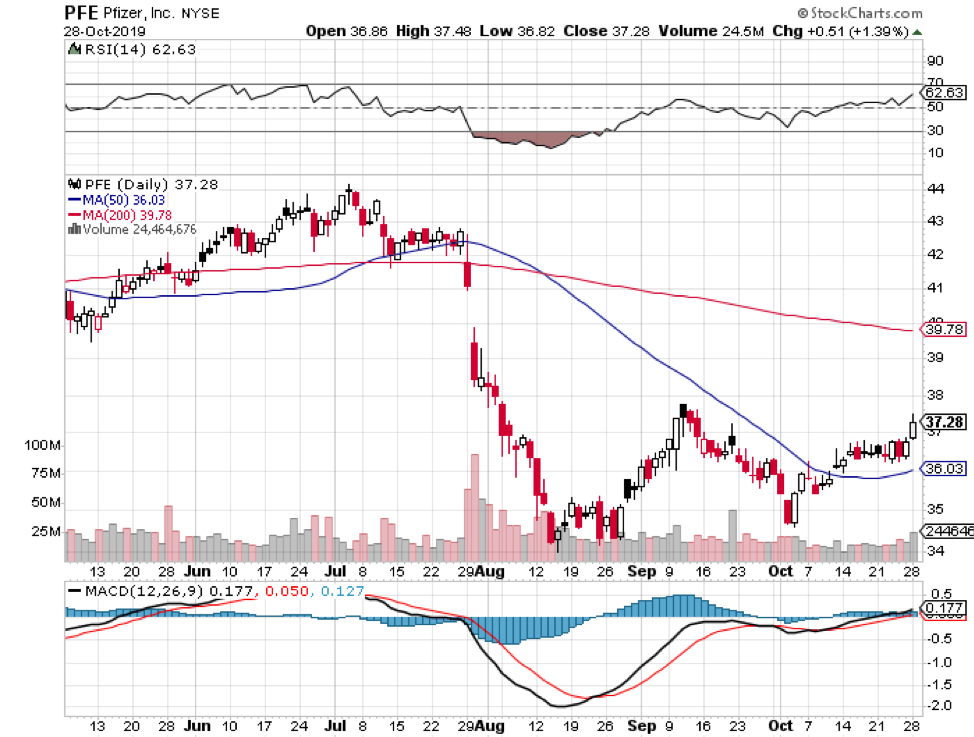
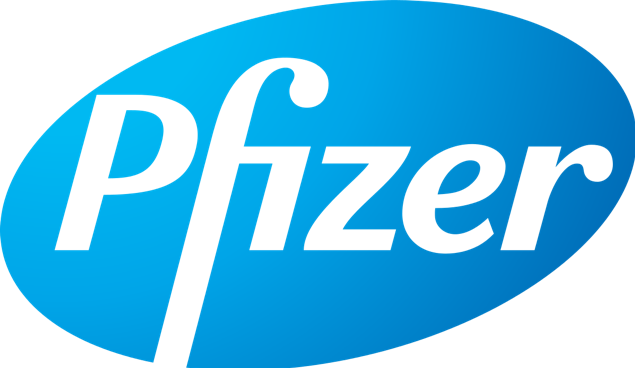
Legal Disclaimer
There is a very high degree of risk involved in trading. Past results are not indicative of future returns. MadHedgeFundTrader.com and all individuals affiliated with this site assume no responsibilities for your trading and investment results. The indicators, strategies, columns, articles and all other features are for educational purposes only and should not be construed as investment advice. Information for futures trading observations are obtained from sources believed to be reliable, but we do not warrant its completeness or accuracy, or warrant any results from the use of the information. Your use of the trading observations is entirely at your own risk and it is your sole responsibility to evaluate the accuracy, completeness and usefulness of the information. You must assess the risk of any trade with your broker and make your own independent decisions regarding any securities mentioned herein. Affiliates of MadHedgeFundTrader.com may have a position or effect transactions in the securities described herein (or options thereon) and/or otherwise employ trading strategies that may be consistent or inconsistent with the provided strategies.
This site uses cookies. By continuing to browse the site, you are agreeing to our use of cookies.
OKLearn moreWe may request cookies to be set on your device. We use cookies to let us know when you visit our websites, how you interact with us, to enrich your user experience, and to customize your relationship with our website.
Click on the different category headings to find out more. You can also change some of your preferences. Note that blocking some types of cookies may impact your experience on our websites and the services we are able to offer.
These cookies are strictly necessary to provide you with services available through our website and to use some of its features.
Because these cookies are strictly necessary to deliver the website, refuseing them will have impact how our site functions. You always can block or delete cookies by changing your browser settings and force blocking all cookies on this website. But this will always prompt you to accept/refuse cookies when revisiting our site.
We fully respect if you want to refuse cookies but to avoid asking you again and again kindly allow us to store a cookie for that. You are free to opt out any time or opt in for other cookies to get a better experience. If you refuse cookies we will remove all set cookies in our domain.
We provide you with a list of stored cookies on your computer in our domain so you can check what we stored. Due to security reasons we are not able to show or modify cookies from other domains. You can check these in your browser security settings.
These cookies collect information that is used either in aggregate form to help us understand how our website is being used or how effective our marketing campaigns are, or to help us customize our website and application for you in order to enhance your experience.
If you do not want that we track your visist to our site you can disable tracking in your browser here:
We also use different external services like Google Webfonts, Google Maps, and external Video providers. Since these providers may collect personal data like your IP address we allow you to block them here. Please be aware that this might heavily reduce the functionality and appearance of our site. Changes will take effect once you reload the page.
Google Webfont Settings:
Google Map Settings:
Vimeo and Youtube video embeds:
